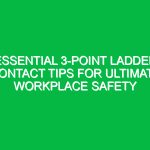Welcome to Our Toolbox Talk
Good morning, team! Today, we are going to discuss an important Safety topic that affects us all—Falls on the Same Level. This Toolbox Talk aims to raise awareness about how to prevent these types of falls and ensure that we all contribute to a safe working Environment. By the end of our discussion, you will have a clearer understanding of the risks involved, best practices for Prevention, and the role each of you plays in maintaining Safety.
Understanding Falls on the Same Level
First, let’s define what we mean by Falls on the Same Level. Unlike falls from heights, which often get a lot of attention, falls on the same level occur when someone slips, trips, or loses their balance and falls to the ground without any elevation involved. These incidents can happen anywhere—from the office floor to the warehouse or construction site—and they can lead to serious injuries, including sprains, fractures, and concussions.
Why Are Falls on the Same Level a Concern?
Statistics show that falls on the same level account for a significant portion of workplace injuries. In fact, according to the National Safety Council, falls are among the leading causes of workplace injuries, with a high rate of occurrences in various industries. The implications are not just physical; they can also lead to increased healthcare costs, lost workdays, and reduced morale among the team.
Common Causes of Falls on the Same Level
To effectively prevent falls on the same level, we need to identify their common causes. Here are several factors to consider:
- Wet or Slippery Surfaces: Spills, rain, or snow can create slippery conditions.
- Uneven Surfaces: Cracks, holes, or uneven flooring can lead to tripping Hazards.
- Obstructed Pathways: Clutter, equipment, or debris in walkways can cause trips.
- Improper Footwear: Shoes that lack grip or support can increase the risk of slipping.
- Poor Lighting: Insufficient lighting can make it difficult to see Hazards.
Real-Life Examples
Let’s consider a couple of hypothetical scenarios where falls on the same level could occur:
Imagine a warehouse employee who is moving boxes and spills some liquid on the floor without marking it. If someone walks by and steps on the spill, they may slip and fall, potentially injuring themselves. In another scenario, an office worker might be in a hurry, rushing to meet a deadline, and trips over a power cord left on the floor. Both examples highlight how easily falls can happen and how quickly they can lead to injury.
Best Practices to Prevent Falls on the Same Level
Now that we understand the causes and implications, let’s discuss some Best Practices to prevent falls on the same level:
- Keep Walkways Clear: Ensure that all pathways are free from clutter and obstacles.
- Clean Up Spills Immediately: Report and clean spills as soon as they occur. Use proper signage to alert others.
- Use Non-Slip Mats: Place mats in high-traffic areas, especially where spills are likely to happen.
- Wear Appropriate Footwear: Ensure that your shoes provide good traction and support.
- Maintain Good Lighting: Make sure that all areas are well-lit and report any burnt-out bulbs.
- Be Aware of Your Surroundings: Always pay attention to where you are walking and anticipate potential hazards.
Encouraging a Safety Culture
Creating a culture of safety is essential in preventing falls on the same level. Here are some ways you can contribute:
- Report Hazards: If you see something unsafe, speak up! Your quick action could prevent an injury.
- Participate in Safety Training: Engage in all safety training sessions and Toolbox Talks to stay informed.
- Look Out for Each Other: Remind your coworkers about potential hazards and encourage Safe Practices.
Regulations and Standards
It’s essential to be aware of the Regulations and standards regarding Workplace Safety. The Occupational Safety and Health Administration (OSHA) provides guidelines to help prevent falls and ensure safety in the workplace. Compliance with these regulations is not only a legal obligation but also a moral one to protect yourself and your colleagues. Failing to adhere to these standards can result in penalties and increased risk of injury.
Open Discussion
Now that we’ve covered a lot of ground, let’s open the floor for discussion. Here are a few questions to consider:
- Have any of you experienced or witnessed a fall on the same level? What happened?
- What strategies do you think would be most effective in preventing falls in our specific work environment?
- Do you have any personal tips or tricks that help you stay safe while working?
Conclusion
In conclusion, preventing falls on the same level is a shared responsibility that requires vigilance and proactive measures. By understanding the risks, following Best Practices, and fostering a culture of safety, we can significantly reduce the likelihood of these incidents in our workplace. Remember, safety is not just an individual effort; it’s a team commitment. Thank you for your attention today, and for your ongoing dedication to maintaining a safe working environment. Let’s keep each other safe out there!


